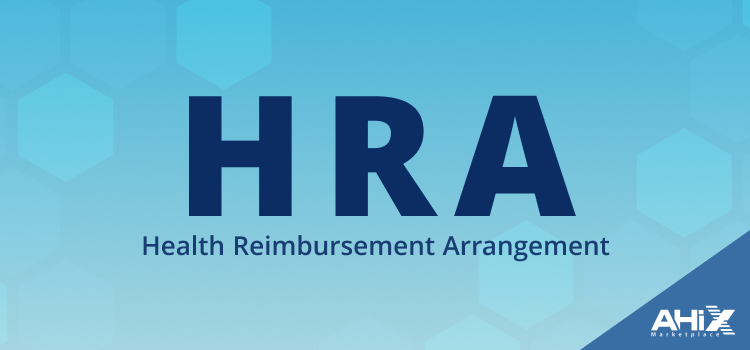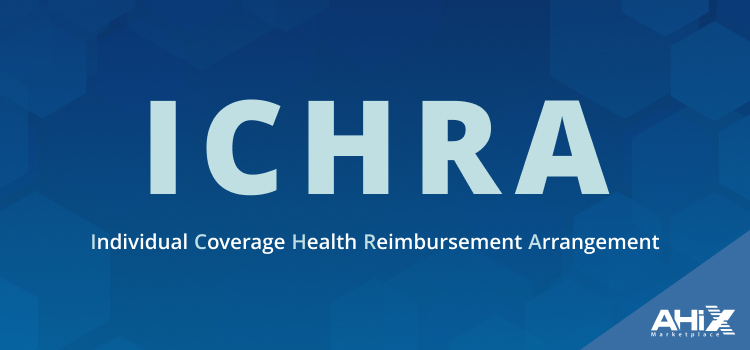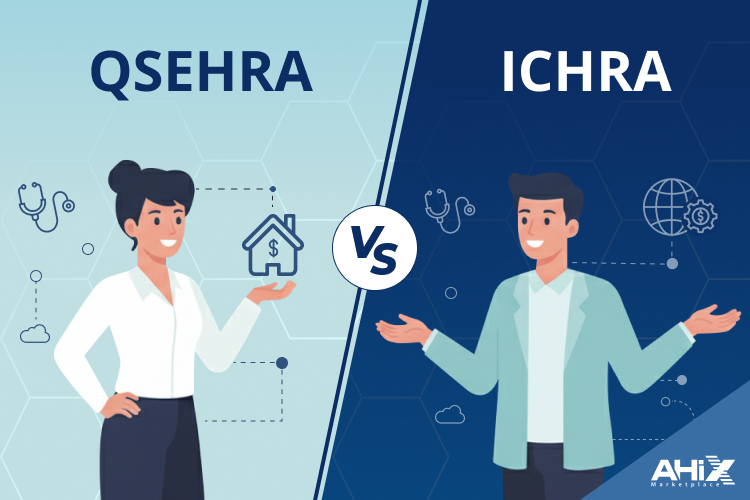Health insurance remains one of the most important and expensive benefits a small business can offer. But as premiums rise and remote work becomes more common, traditional group health insurance is no longer the only option. Many small employers are turning to health reimbursement arrangements (HRAs) as flexible, cost-controlled alternatives.
Two of the most popular HRA models are QSEHRA and ICHRA. Both let employers reimburse employees for their own individual health insurance premiums and out-of-pocket medical expenses tax-free. But which one is better for your business?
In this guide, we’ll break down the differences between QSEHRA vs ICHRA, explore who can offer each, how they work, and which plan may be a better fit for your business in 2025-26. Whether you’re a startup with remote employees or a local shop with under 50 staff, this comparison will help you make a smarter benefits decision.
What Is an HRA?

Before comparing QSEHRA vs ICHRA, it’s important to understand what an HRA actually is.
A Health Reimbursement Arrangement (HRA) is an employer-funded health benefit that reimburses employees for qualified medical expenses, often including monthly insurance premiums. Unlike traditional group health insurance, an HRA gives employees the freedom to shop for their own coverage while the employer controls costs by setting a fixed reimbursement amount.
Here’s how it works:
- The employer sets a monthly or annual allowance.
- The employee purchases an individual health insurance plan.
- The employee submits proof of qualified expenses.
- The employer reimburses the employee tax-free, up to the allowed limit.
HRAs are regulated by the IRS and are not health insurance themselves. Instead, they are a way for businesses to contribute to their employees’ healthcare costs without managing a group plan.
Among several HRA types, the two most commonly used by small and midsize employers are QSEHRA and ICHRA, and they differ in key ways that we’ll break down next.
What Is QSEHRA?

QSEHRA stands for Qualified Small Employer Health Reimbursement Arrangement. It was introduced by Congress in 2017 as a way for small businesses to offer health benefits without the complexity or cost of a traditional group insurance plan.
To offer a QSEHRA, your business must meet two conditions:
- You have fewer than 50 full-time employees, and
- You do not offer a group health insurance plan.
With a QSEHRA, the employer sets a monthly allowance, and employees use that money to buy their own individual health insurance and get reimbursed for other qualified medical expenses. The reimbursements are tax-free for both the employer and employee, as long as the employee has Minimum Essential Coverage (MEC).
QSEHRA also has annual contribution limits that are adjusted by the IRS each year. For 2025, the expected limits are approximately:
- $6,150 for self-only coverage
- $12,450 for family coverage
These limits make the QSEHRA ideal for smaller businesses seeking to offer meaningful yet predictable health benefits. It’s also relatively easy to set up and administer, with minimal reporting requirements.
Up next, we’ll look at how ICHRA compares, especially for businesses with more flexibility or complex team structures.
What Is ICHRA?

ICHRA stands for Individual Coverage Health Reimbursement Arrangement. It’s a more flexible option than QSEHRA designed to give businesses of nearly any size a way to reimburse employees for their own health insurance plans and eligible medical expenses.
Here’s what distinguishes ICHRA:
1. Employer Size & Eligibility
Unlike QSEHRA, there is no limit on company size for offering ICHRA. Whether you have five employees or 500, your business may qualify. The key requirement is that each employee enrolled under the ICHRA must have individual health insurance, either through the ACA marketplace or from a private insurer. This is part of the ICHRA eligibility rules.
2. Flexible Employee Classes
ICHRA allows companies to divide employees into permitted classes full‑time vs part‑time, geographic location, seasonal, salaried vs hourly, etc. Each class can have a different reimbursement amount. This flexibility helps tailor health benefits more fairly across diverse workforces.
3. No Annual Reimbursement Limit
One of the most significant advantages: there’s no IRS‑set cap on how much an employer can reimburse under ICHRA. That makes it ideal if your employees need higher allowances or you want to cover larger medical expenses.
4. Qualifying Insurance & Coverage Requirements
For reimbursements to be tax‑free under ICHRA, the employee must have a plan that meets certain standards. Typically, that means Minimum Essential Coverage (MEC). The employer must ensure that the health plan qualifies under federal rules.
5. Compliance & Notice
Employers offering ICHRA must follow notice requirements (inform employees at least 90 days before the start of the coverage period) and ensure non‑discrimination across employee classes. Also, affordability requirements need to be met if the business is large enough to have ACA obligations.
6. Best Fit Scenarios
ICHRA works best for businesses that:
- Employ people in multiple states, where health insurance markets vary.
- Want to provide high reimbursements (family plans, high‑deductible coverage).
- Have different types of employees needing different benefit levels.
QSEHRA vs ICHRA: A Side-by-Side Comparison
Understanding the differences between QSEHRA vs ICHRA is essential when choosing the right health benefit for your business. While both offer tax-free reimbursements for employee healthcare, they serve different needs and offer distinct features.
Here’s a clear HRA plan comparison:
| Feature | QSEHRA | ICHRA |
|---|---|---|
| Eligibility | Employers with fewer than 50 full-time employees (FTEs) | Employers of any size |
| Group Insurance Allowed? | No | No |
| Annual Reimbursement Limits (2025) | ~$6,150 single / ~$12,450 family | No IRS limit |
| Employee Classes | Not allowed | 11 allowed classes (e.g., full-time, part-time, remote) |
| Use of Premium Tax Credits (PTC) | Allowed, but reduces dollar-for-dollar | Must opt out if ICHRA is affordable |
| Insurance Requirement | Minimum Essential Coverage (MEC) | Minimum Essential Coverage (MEC) |
| Administrative Simplicity | Easier to set up | More flexible, but requires more setup |
| Best For | Very small teams with basic needs | Growing or remote teams; companies with varying employee types |
QSEHRA is ideal for micro-businesses wanting simplicity and IRS-capped contributions.
ICHRA offers more customization and scale, especially valuable if your workforce spans different states or job types.
This comparison makes it easier to identify which HRA structure aligns with your business goals and compliance needs.
QSEHRA vs ICHRA: Which One Is Right for Your Business?

Choosing between QSEHRA and ICHRA depends on several key factors specific to your business. Below is a focused guide to help you determine which reimbursement model better supports your employee health benefits strategy.
1. Business Size
If your company has fewer than 50 full-time employees, you may be eligible for QSEHRA. Businesses of any size can offer ICHRA, making it more versatile for growing teams or larger employers.
If you’re asking, “Can I offer QSEHRA if I have 30 employees?” the answer is yes. For 100 employees? ICHRA is your path.
2. Employee Location & Structure
Do you have remote workers, contractors, or teams across multiple states? ICHRA is often better suited here. It allows you to group employees by class (e.g., part-time vs full-time, salaried vs hourly) and offer varied reimbursement amounts.
QSEHRA treats all employees the same, a good fit only if your team is small, local, and relatively uniform in needs.
3. Budget Control
QSEHRA comes with IRS-set reimbursement limits, making it ideal if you want a predictable, capped benefit. ICHRA has no annual limit, offering more freedom to set generous allowances but also requiring closer planning.
4. Simplicity vs Flexibility
QSEHRA is simpler to administer and works well for very small companies just starting out. ICHRA provides more design flexibility like customizing benefits by department, location, or employee type but it requires more setup, compliance checks, and plan structuring.
5. Interaction with Tax Credits
If your employees use Premium Tax Credits (PTC) to lower ACA plan costs, it affects both HRAs differently:
- QSEHRA: The reimbursement amount will reduce any tax credit the employee gets.
- ICHRA: Employees must opt out of tax credits if the ICHRA is deemed “affordable” under ACA rules.
Knowing this helps you avoid disrupting your team’s existing coverage unexpectedly.
Bottom Line:
- Choose QSEHRA if you’re a small, local team looking for a low-cost, easy-to-manage benefit.
- Choose ICHRA if you need scalable, customizable health benefits for a diverse or remote workforce.
Still unsure? Platforms like AHiX Marketplace can support your employees in comparing eligible ACA plans that work with either QSEHRA or ICHRA, helping everyone get the most from their reimbursement.
Tax Benefits and Compliance Rules for QSEHRA and ICHRA
Both QSEHRA and ICHRA offer valuable tax advantages, but they also come with specific IRS compliance requirements that employers must follow. Understanding these rules can help you avoid penalties and get the most value out of your health reimbursement strategy.
Tax Benefits for Employers and Employees
With both QSEHRA and ICHRA, reimbursements made for qualifying premiums and medical expenses are:
- 100% tax-deductible for the employer
- Free from federal income and payroll tax for the employee
This means employers can offer health support without increasing their taxable payroll, while employees receive non-taxable health benefits, a win for both sides.
Compliance Obligations You Should Know
While the tax perks are substantial, HRAs must follow IRS rules:
For QSEHRA:
- You cannot offer a group health plan at the same time.
- You must report annual QSEHRA contributions on each employee’s Form W-2.
- Employees must carry Minimum Essential Coverage (MEC) for the reimbursement to be tax-free.
For ICHRA:
- You must provide a 90-day advance notice before each plan year begins.
- If you’re an Applicable Large Employer (ALE) (50+ employees), ICHRA must pass the affordability test under the ACA to avoid penalties.
- You must offer coverage to employee classes fairly and consistently, without discrimination.
Failing to meet these compliance steps could result in IRS fines or a loss of tax advantages. If your business needs help ensuring everything is set up correctly, licensed agents or benefits platforms can help guide you through the setup.
Real-World Use Cases: How Small Businesses Use QSEHRA and ICHRA

Understanding the mechanics of QSEHRA and ICHRA is helpful, but seeing how real businesses use them makes the differences even clearer. Below are examples that illustrate how these health reimbursement plans can be applied in practical business scenarios.
QSEHRA for a Small Local Business
A small bakery in Ohio with 10 full-time employees doesn’t offer group health insurance due to high costs. Instead, the owner sets up a QSEHRA, offering each employee $300 per month in tax-free reimbursements. Employees use this to help pay for their ACA-compliant plans, and the business keeps its benefit costs predictable and manageable. The setup is simple, and there’s no need to manage a traditional insurance policy.
This is a common QSEHRA for a small business scenario: a single-location team with uniform roles and minimal administrative capacity.
ICHRA for a Remote Tech Startup
A 25-person software company with employees spread across California, Texas, and Florida wants to offer health benefits without juggling state-specific group plans. They implement an ICHRA, setting different reimbursement amounts for full-time and part-time employees using permitted classes. Employees are free to choose individual health plans that meet their personal and regional needs.
This example highlights how ICHRA for remote teams allows flexible benefits without locking into a single insurance provider. It’s also scalable if the company grows to 100 employees, the ICHRA can grow with them.
Which Plan Do These Examples Support?
- QSEHRA is often ideal for small, locally rooted businesses with simple needs and under 50 employees.
- ICHRA is well-suited for growing companies, multi-state employers, or businesses that want to tailor health benefits by role, location, or employment status.
These real-world HRA plan examples demonstrate how both options can work effectively, depending on your business model, budget, and workforce structure.
How AHiX Helps Employees Use QSEHRA or ICHRA Benefits
Once an employer sets up a QSEHRA or ICHRA, the next step falls on the employee to choose an individual health insurance plan that meets eligibility requirements.
That’s where AHiX can help.
As an employee health coverage marketplace, AHiX connects individuals with ACA-compliant health plans that are fully compatible with both QSEHRA and ICHRA. Employees can compare plans side by side, filter based on premiums, deductibles, and networks, and enroll quickly with licensed assistance if needed.
This guidance is especially useful when:
- Employees are unfamiliar with the individual market.
- They’re deciding between on-exchange vs. off-exchange plans.
- They want to ensure their plan qualifies for tax-free reimbursement under their employer’s HRA.
For employers, this means fewer questions and more confident employees making informed decisions about their health coverage.
Whether you’re just setting up a reimbursement model or trying to support a multi-state team, AHiX helps bridge the gap between reimbursement allowances and smart health plan selection.
Final Thoughts: Choosing Between QSEHRA vs ICHRA for Your Business
Choosing between QSEHRA vs ICHRA ultimately depends on your business’s size, structure, and benefit goals. Both options provide employers with a means to control costs while offering valuable, tax-advantaged health coverage to employees.
- QSEHRA is ideal for small businesses with under 50 employees that want a simple, budget-friendly solution with IRS-defined limits.
- ICHRA offers more customization, scalability, and flexibility, especially useful for remote teams, growing companies, or multi-location organizations.
As traditional group plans become more complex to manage and more expensive, these health reimbursement plans provide modern alternatives that put choice and control back into the hands of both employers and employees.
If you’re considering a shift in how you handle employee health benefits, understanding the full picture of QSEHRA vs ICHRA is the first step. And when your employees are ready to choose individual coverage, platforms like AHiX Marketplace can help them find ACA-compliant plans that align with their unique needs and budget.


